|
From “A
Brief History of the Calculator” by Natalia Koval and
Max Whitacre:
The
Mechanical Calculator
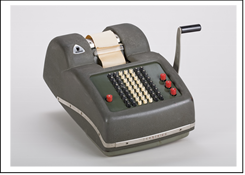
|
The mechanical calculator was a 17th century
mechanical device used to automatically perform
the basic operations of arithmetic. The first of
these mechanical calculators was designed by
Wilhelm Schickard in 1642. Mechanical calculators
were produced until the 1970's, but they were most
popular in the late '40s and early '50s-- the
hand-held and portable Curta mechanical calculator
was developed around then.
|
The Electronic Calculator
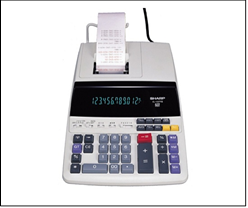
|
Although the first electronic calculator was
developed by the Casio Computer Computer Company in
1957, the first handheld electronic calculators were
not developed until the design of the "Cal Tech"
prototype in 1967 by Texas Instruments. Calculators
became more common in the 1970s. By 1970, a
calculator could be made using just a few chips of
low power consumption, allowing portable models
powered from rechargeable batteries. The first
portable calculators appeared in Japan in 1970, and
were soon marketed around the world. |
Programmable & Graphing Calculators
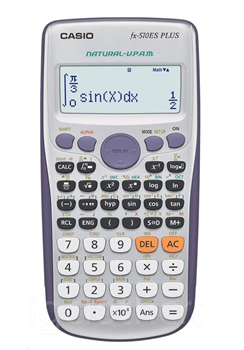
|
Programmable calculators were first introduced by
Mathatronics and Casio in the mid-1960s; however,
these machines were very heavy and expensive. In the
Soviet Union, desktop programmable calculators had
been introduced in the '70s, but the first pocket
programmable calculator (the Elektronika B3-21) was
developed around the end of 1977. Despite its
limited capabilities, a hacker culture surfaced
around these Elektronika calculators-- adventure
games and wide libraries of calculus-related
functions for engineers were programmed by these
hackers. A similar hacker culture surfaced around
the HP-34 (an American calculator). Graphing
calculators were first introduced in 1985 by Casio.
Now, graphing calculators like the TI-Nspire are
capable of not only graphing, evaluation of
arithmetic expressions, evaluation of probability,
solving equations for you, and a wide variety of
other mathematical, geometric, and trigonometric
operations-- they are programmable, and have their
own operating systems that are released
periodically. |
The mechanical calculator was limited, at first, to
addition and subtraction. Later models incorporated
multiplication and division. However, they were somewhat
difficult to operate and slow. They were also constrained
by the precision (the number of the decimal places before
and after the decimal point) that they produced, but the
answers were accurate. Given these limitations, the
mechanical calculator was used for only the most basic of
computations in engineering.
The electronic calculator resolved the problems of the
slide ruler and mechanical calculator and was a great boon
to engineers. The electronic calculator also allowed for
greater mathematical operations, and later for simple
programming operations. They still had a limitation on
precision (based on the circuitry used to perform the
calculation) but they had much greater precision than a
slide ruler or mechanical calculator. As a result,
engineers could now design for smaller tolerances, which
reduced the size and weight, led to greater efficiencies,
and reduced the costs of the product. More information can
be found on the Wikipedia Article on Calculators.
Computers
Mainframe
Computers
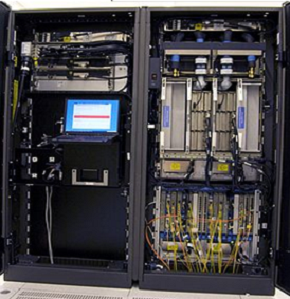 |
Mainframe computers (colloquially
referred to as "big iron") are computers used
primarily by large organizations for critical
applications, bulk data processing, such as
census, industry and consumer statistics,
enterprise resource planning, and transaction
processing.
The term originally referred to the large
cabinets called "main frames" that housed the
central processing unit and main memory of early
computers. Later, the term was used to distinguish
high-end commercial machines from less powerful
units. Most large-scale computer system
architectures were established in the 1960s but
continue to evolve.
The initial manufactures of mainframe computers
were IBM, Burroughs, Univac, Sperry-Rand, and GE.
|
Minicomputers
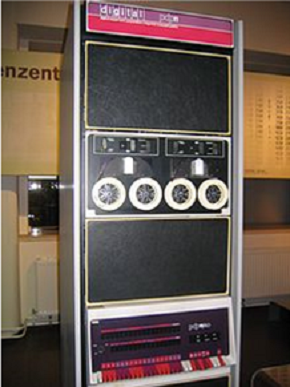 |
A minicomputer, or colloquially
mini, is a class of smaller computers that was
developed in the mid-1960s and sold for much less
than mainframe and mid-size computers from IBM and
its direct competitors. In a 1970 survey, the New
York Times suggested a consensus definition of a
minicomputer as a machine costing less than
US$25,000, with an input-output device such as a
teleprinter and at least four thousand words of
memory, that is capable of running programs in a
higher-level language, such as Fortran or BASIC. The
class formed a distinct group with its own software
architectures and operating systems. Minis were
designed for control, instrumentation, human
interaction, and communication switching as distinct
from calculation and record keeping. Many were sold
indirectly to original equipment manufacturers
(OEMs) for final end use application. During the
two-decade lifetime of the minicomputer class
(1965–1985), almost 100 companies formed and only a
half dozen remained.
When single-chip CPU microprocessors appeared,
beginning with the Intel 4004 in 1971, the term
"minicomputer" came to mean a machine that lies in
the middle range of the computing spectrum, in
between the smallest mainframe computers and the
microcomputers. The term "minicomputer" is little
used today; the contemporary term for this class
of system is "midrange computer", such as the
higher-end SPARC, Power Architecture and
Itanium-based systems from Oracle, IBM and
Hewlett-Packard.
The initial manufactures of minicomputers were
Digital Equipment Corporation (DEC), Data General,
Prime, Computervision, Honeywell and Wang
Laboratories |
Workstation Computers
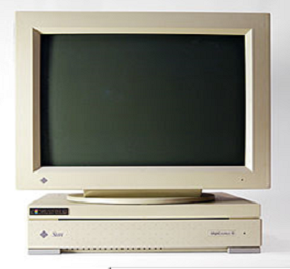 |
A workstation is a special
computer designed for technical or scientific
applications. Intended primarily to be used by one
person at a time, they are commonly connected to a
local area network and run multi-user operating
systems. The term workstation has also been used
loosely to refer to everything from a mainframe
computer terminal to a PC connected to a network,
but the most common form refers to the group of
hardware offered by several current and defunct
companies such as Sun Microsystems, Silicon
Graphics, Apollo Computer, DEC, HP, NeXT and IBM
which opened the door for the 3D graphics animation
revolution of the late 1990s.
Workstations offered higher performance than
mainstream personal computers, especially with
respect to CPU and graphics, memory capacity, and
multitasking capability. Workstations were
optimized for the visualization and manipulation
of different types of complex data such as 3D
mechanical design, engineering simulation (e.g.,
computational fluid dynamics), animation and
rendering of images, and mathematical plots.
Typically, the form factor is that of a desktop
computer, consist of a high-resolution display, a
keyboard and a mouse at a minimum, but also offer
multiple displays, graphics tablets, 3D mice
(devices for manipulating 3D objects and
navigating scenes), etc. Workstations were the
first segment of the computer market to present
advanced accessories and collaboration tools.
The increasing capabilities of mainstream PCs in the
late 1990s have blurred the lines somewhat with
technical/scientific workstations. The
workstation market previously employed proprietary
hardware which made them distinct from PCs; for
instance, IBM used RISC-based CPUs for its
workstations and Intel x86 CPUs for its
business/consumer PCs during the 1990s and 2000s.
However, by the early 2000s this difference
disappeared, as workstations now use highly
commoditized hardware dominated by large PC vendors,
such as Dell, Hewlett-Packard (later HP Inc.) and
Fujitsu, selling Microsoft Windows or Linux systems
running on x86-64 architecture such as Intel Xeon or
AMD Opteron CPU Microcomputers 1980 to present. |
Microcomputers
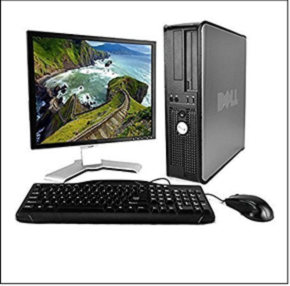 |
The first microcomputer was the
Japanese Sord Computer Corporation's SMP80/08
(1972), which was followed by the SMP80/x (1974).
The French developers of the Micral N (1973) filed
their patents with the term "Micro-ordinateur", a
literal equivalent of "Microcomputer", to designate
a solid-state machine designed with a
microprocessor. In the USA, the earliest models such
as the Altair 8800 and Apple I were often sold as
kits to be assembled by the user, and came with as
little as 256 bytes of RAM, and no input/output
devices other than indicator lights and switches,
useful as a proof of concept to demonstrate what
such a simple device could do. However, as
microprocessors and semiconductor memory became less
expensive, microcomputers in turn grew cheaper and
easier to use.
All these improvements in cost and usability
resulted in an explosion in their popularity
during the late 1970s and early 1980s. A large
number of computer makers packaged microcomputers
for use in small business applications. By 1979,
many companies such as Cromemco, Processor
Technology, IMSAI, North Star Computers, Southwest
Technical Products Corporation, Ohio Scientific,
Altos Computer Systems, Morrow Designs and others
produced systems designed either for a resourceful
end user or consulting firm to deliver business
systems such as accounting, database management,
and word processing to small businesses. This
allowed businesses unable to afford leasing of a
minicomputer or time-sharing service the
opportunity to automate business functions,
without (usually) hiring a full-time staff to
operate the computers. A representative system of
this era would have used an S100 bus, an 8-bit
processor such as an Intel 8080 or Zilog Z80, and
either CP/M or MP/M operating system. The
increasing availability and power of desktop
computers for personal use attracted the attention
of more software developers. In time, and as the
industry matured, the market for personal
computers standardized around IBM PC compatibles
running DOS, and later Windows. Modern desktop
computers, video game consoles, laptops, tablet
PCs, and many types of handheld devices, including
mobile phones, pocket calculators, and industrial
embedded systems, may all be considered examples
of microcomputers according to the definition
given above.
The initial manufactures of microcomputers that
gained wide acceptance were Apple, Radio Shack,
Commodore, Osborne, and Kaypro. The later
manufactures of microcomputers were Apple, IBM,
Compaq, Dell Computer, Packard Bell, AST Research,
and Gateway 2000. Today there are literally dozens
of manufactures of microcomputers. |
Supercomputers
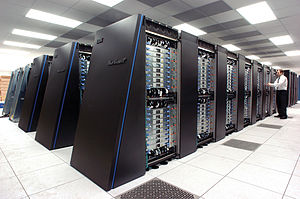 |
A supercomputer is a computer
with a high level of computing performance compared
to a general-purpose computer. Performance of a
supercomputer is measured in floating-point
operations per second (FLOPS) instead of million
instructions per second (MIPS). As of 2015, there
are supercomputers which can perform up to
quadrillions of FLOPS, measured in P(eta)FLOPS. The
majority of supercomputers today run Linux-based
operating systems.
Supercomputers play an important role in the
field of computational science, and are used for a
wide range of computationally intensive tasks in
various fields, including quantum mechanics,
weather forecasting, climate research, oil and gas
exploration, molecular modeling (computing the
structures and properties of chemical compounds,
biological macromolecules, polymers, and
crystals), and physical simulations (such as
simulations of the early moments of the universe,
airplane and spacecraft aerodynamics, the
detonation of nuclear weapons, and nuclear
fusion). Throughout their history, they have been
essential in the field of cryptanalysis.
Supercomputers were introduced in the 1960s, and for
several decades the fastest were made by Seymour
Cray at Control Data Corporation (CDC), Cray
Research and subsequent companies bearing his name
or monogram. The first such machines were highly
tuned conventional designs that ran faster than
their more general-purpose contemporaries. Through
the 1960s, they began to add increasing amounts of
parallelism with one to four processors being
typical. From the 1970s, the vector computing
concept with specialized math units operating on
large arrays of data came to dominate. A notable
example is the highly successful Cray-1 of 1976.
Vector computers remained the dominant design into
the 1990s. From then until today, massively parallel
supercomputers with tens of thousands of
off-the-shelf processors became the norm. |
The computer had a tremendous impact on engineering, as
it resolved all the issues of the slide ruler, mechanical
calculator, and the electronic calculator. In addition, it
had a full array of mathematical operations, with much
greater precision, and was fully programmable for complex
calculations. As computers became faster, smaller, and
less expensive they were integrated into engineering at
all levels. They even spawned the development of Computer
Aided Design (CAD), Computer Aided Engineering (CAE), and
Computer Aided Manufacturing (CAM) software applications.
The subject of Computer Modeling and its Issues, Concerns,
and Limitations is another paper that I have written and
is beyond the scope of this paper. I would direct you to
this paper “Computer Modeling” for further information.
Below is the recap of this paper.
Conclusions
Mathematical Tools are like any other tool - they can be
used properly or improperly, by a skilled or unskilled
persons, and even if used properly in the hands of a
skilled person they can produce improper or incorrect
results. When used in the hands of of a biased person they
can give the false illusion of correctness and believably
of the results, as I have examined in another article of
mine, Oh What a Tangled Web We Weave.
Consequently, we should all be wary of Mathematical Tools
results, and verify to the best of our ability their
correctness before we proceed with the results. We should
also remember that there are things that we know, things
that we know we don't know, and things that we don't know
that we don't know—and it is the things that we don't know
that we don't know where the serious problems often arise.
Disclaimer
Please Note - many academics, scientist
and engineers would critique what I have written here as
not accurate nor through. I freely acknowledge that these
critiques are correct. It was not my intentions to be
accurate or through, as I am not qualified to give an
accurate nor through description. My intention was to be
understandable to a layperson so that they can grasp the
concepts. Academics, scientists, and engineers entire
education and training is based on accuracy and
thoroughness, and as such, they strive for this accuracy
and thoroughness. I believe it is essential for all
laypersons to grasp the concepts of this paper, so they
make more informed decisions on those areas of human
endeavors that deal with this subject. As such, I did not
strive for accuracy and thoroughness, only
understandability.
Most academics, scientist, and engineers when speaking or
writing for the general public (and many science writers
as well) strive to be understandable to the general
public. However, they often fall short on the
understandability because of their commitment to accuracy
and thoroughness, as well as some audience awareness
factors. Their two biggest problems are accuracy and the
audience knowledge of the topic.
Accuracy is a problem because academics, scientist,
engineers and science writers are loath to be inaccurate.
This is because they want the audience to obtain the
correct information, and the possible negative
repercussions amongst their colleagues and the scientific
community at large if they are inaccurate. However,
because modern science is complex this accuracy can, and
often, leads to confusion amongst the audience.
The audience knowledge of the topic is important as most
modern science is complex, with its own words,
terminology, and basic concepts the audience is unfamiliar
with, or they misinterpret. The audience becomes confused
(even while smiling and lauding the academics, scientists,
engineers or science writer), and the audience does not
achieve understandability. Many times, the academics,
scientists, engineers or science writer utilizes the
scientific disciplines own words, terminology, and basic
concepts without realizing the audience
misinterpretations, or has no comprehension of these
items.
It is for this reason that I place understandability as
the highest priority in my writing, and I am willing to
sacrifice accuracy and thoroughness to achieve
understandability. There are many books, websites, and
videos available that are more accurate and through. The
subchapter on “Further Readings” also contains books on
various subjects that can provide more accurate and
thorough information. I leave it to the reader to decide
if they want more accurate or through information and to
seek out these books, websites, and videos for this
information.
© 2025. All rights
reserved.
If you have any comments, concerns, critiques, or
suggestions I can be reached at mwd@profitpages.com.
I will review reasoned and intellectual correspondence,
and it is possible that I can change my mind,
or at least update the content of this article. |









